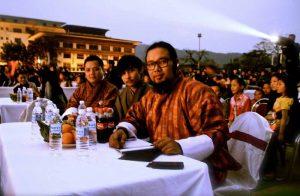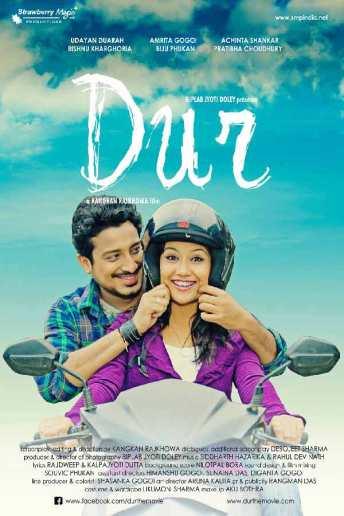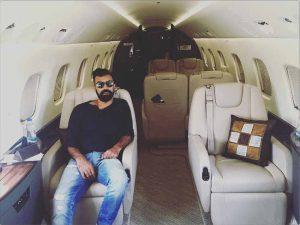Born in a small little town in the Dhemaji district of Assam, Biplab Doley has always been living with the dream of doing something for the community and make a mark in the society.
His dream turned into a reality when he became the first from his community and the first from his state to work in an international project in Bhutan. However, this was not his first stint. He had been associated with numerous international projects, be it documentaries, commercials or feature films. He had been associated with over 40 documentaries, telecast on various channels like National Geographic Channel, Discovery Channel, BBC, History TV, NDTV etc and also several commercials for Airtel India, Maruti Suzuki and so on. He had been related with a few worldwide honours winning undertakings like 'Thank You, Sir', 'One Cat Diary,' and so on. He currently owns two media companies viz. Strawberry Magic Productions and Siyang Motion Pictures and Film Society.
Biplab shared in details with The Moviean about his upcoming film Singye, about turning into a producer for the first Indo-Bhutan film. Find out what we asked him and his straight forward answers below:
The Moviean(TM): Tell us about Singye. How and why did you decide to turn a producer for a Bhutanese film?
Biplab Doley(BD): Singye is a culmination of a long-term dream. It is a beautiful project and supposedly the first Indo-Bhutan feature film production. The concept of an Indo-Bhutan production struck me when I landed in Bhutan for the first time as the Director of Photography for the National Award winner 'Thank You, Sir!,'directed by the two time National Award winning director Mr. Tshering Gyeltshen.
Bhutanese Film industry is a budding industry whereas the Assamese film industry, although a century old, is still struggling. And I found the land, people and its culture in Bhutan is a lot similar to us than we could imagine. The stories of this land needed to be told and shared, and what better way of telling a story than through films. There are beautiful stories in both the lands, but people had to be convinced to share the stories. Someone had to take the lead and that's how I stepped in as a producer.
From hardly 2 films in 2009 to 24 films released in 2017, I think is a huge jump for Assamese cinema.
TM: Singye is your third Bhutanese film overall, but first as a producer. How did someone from Assam land up doing a Bhutanese film?
BD: It's not the third, there had been a couple of more projects I had been associated with but yes, this one is the biggest of the lot. And like I said, Bhutan as a country always awed me and it is thanks to director Tshering Gyeltshen, who had invited me to lead the technical team of 'Thank You, Sir!!!'. I was working in Delhi then, and I had come home for some emergency and that's when he got in touch with me through a colleague and turns out his younger brother, Mr. Tenzee Norbu, who was also the Associate Director in the film was my classmate in Delhi, when I was doing my Post-Graduation. I landed up in Bhutan on a three months contract; the contract extended to a year and the rest is history.

TM: Tell us about the Bhutanese film market (what role does the royal family of Bhutan have in the film industries). How different is it from the Indian films.
BD: The Bhutanese film industry is pretty new. Commercialization probably started only around the 2000s. There is no distribution system as of yet and even the film policy is still being drafted. But despite all the shortcomings, it is so encouraging to see beautiful films being made and released from this tiny Himalayan Kingdom. Everyone is talking films and the youth are so passionate about being involved with one. Films like 'Travellers and Magicians,' 'Honeygiver Among The Dogs,' 'Hema Hema,' etc. have rocked many international festivals abroad. And the biggest encouragement for a producer like me, who is used to the brutal taxation system in our country gets a sigh of relief if we invest in a film there because the government is pretty lenient, compared to us, when it comes to all these. And yes, you asked about the involvement of the Royals in films. Well, they are not directly involved but they are very encouraging. In fact, everyone in the top administrative positions in Bhutan is so approachable and kind that we as artists get an ultimate morale boost to give our best.
Out here in Assam, we are more casual in our approach. Maybe our 'Laahe Laahe' (Slowy slowly) attitude has seeped into our working styles.
One more interesting thing I noticed when I first watched a Bhutanese film was, all the actors had to be in their traditional attire. It was pretty interesting to witness how they tried to maintain their culture and value them. In fact, even when it comes to building and town policies also, its very interesting to see that their cultural designs are preserved. However, at the same time, this was somehow holding back as to how a character was portrayed in films. I mean, you would see all the characters, be it the protagonists or the antagonists wearing the same thing, wherein costumes are a very significant part in defining a character. But, now, things are changing and they are more accepting of this fact.
TM: Is Singye a risky gamble as a producer? Are you planning for India release as well?
Every business is risky, and so is film business. But, I am a filmmaker before being a producer. I make films out of sheer passion and Singye is one of my few attempts of collaborating the brotherhood of the two nations and witness a beautiful cultural fusion in the days to come. This initiative also I feel will open the gates for people of the two nations to explore more opportunities and avenues and will have a bigger market for producers in the future to break even. We can probably draft a new film policy wherein we have clauses which state easier procedure for cross country release of films in the future. And yes, releasing Singye in India is on the cards.
TM: You have produced an Assamese film (Dur) and now a Bhutanese movie? How different are the two industries? Which other language films are you planning to produce films for?
BD: The first thing you notice when you work in a Bhutanese film is that they are very organized and proper. Pre-production, production and post-production processes are better organized and streamlined. It's basically like when you live in a small house, you start organizing your things better. It gets easier too. However, once the industry grew bigger, if they can maintain the same work culture, this industry is going places for sure.
Out here in Assam, we are more casual in our approach. Maybe our 'Laahe Laahe' attitude has seeped into our working styles. That's one of the reasons I always wanted to witness a conglomeration of the two industries. We are technically better off and they in the way they approach work. A fusion of the two could witness a rapid growth in the industry of both the countries and for filmmakers like us, nothing like it, isn't it?


TM: We know you as a producer of Dur, DoP of Baeyul, Thank You Sir, and now Singye. What's Biplab like in real life? Tell us about the person in you.
BD: Haha, I am just like any other normal human being but probably, a little crazy at times when it comes to films. I love to eat, sleep and dream cinema. There are times when I switch off my phone and I watch films 3-4 days non-stop in a row. Sometimes my friends and family think I am nuts. But that's me. And that's how probably I got into films. When I was young, there was this quaint little cinema hall in our little hometown. It was a wooden building with a thatch roof (which they changed to tin after it started leaking water during the rains). The front seats were wooden benches, the middle row had wooden chairs and the last row special seats were plastic. The last row tickets I think were Rs. 6-7 and you indeed felt special because you could hear the projector crank when the film started. Even the ticket counter was nothing more but two cubby holes, one each for Male and Female. Oh, how I loved the smell of the ticket. It was some pink and yellow counterfoil. A few frontbenchers even smoked bidi inside the hall and you could easily make out if a person had gone for a movie if you get the smell of bidi and that sweat (haha). The projectionist was a neighbour and I had this few occasions where I had this privilege to watch a film from the projection room. The film can, the celluloid, the reels...and like you say, the rest is history. Its sheer nostalgia and it became my ultimate dream to recreate those moments in my life.
TM: When we say or hear the term producer we think that there is this person who puts his money on a project and when the films become a success he takes home the money... but what exactly is the role of a producer?
BD: When we visualize a producer, it's always this fat guy in a white kurta with all the blings, who does nothing but talks money. But it is not always that. In fact, I feel the role of a producer in a film is as much as the Director, Actor or any creative people involved with the film. Without any idea of the script, the technicalities involved, one cannot produce a film. Let's say for instance when we say 'a farmer produces rice,' does it mean he just buys the seeds and throws in a paddy field? No right? He waters them, nurtures them and takes care of them till its time to reap. It's the same with films. And these days we have financers who actually puts in the money and the producers usually segregate the budget for each process of productions and make the best use of the money possible to get the best results.
TM: What are the challenges of being an Assamese (regional/language) filmmaker and a producer?
BD: I think the challenges are the same as in any industry; only the scale is bigger or smaller depending on the project. But one of the biggest challenges as a producer in this industry is the risk of returns. The many producers still producing films here are doing it out of sheer passion and not profit. And that's worth appreciating. The industry here is not even a full-fledged industry per se. There are only a handful of people living solely out of films in this industry. Most of them have different business ventures.
the biggest encouragement for a producer like me, who is used to the brutal taxation system in our country gets a sigh of relief if we invest in a film there because the government is pretty lenient, compared to Ours
TM: Filmmakers today have various other options to put their films on like Netflix, Amazon Prime, and many other VOD streaming websites. In fact, there are regional streaming sites as well. What's your take on this? Are any of your films available online?
BD: I think it's a good platform for low budget films and the new lot of indie filmmakers. Because many distributors don't want to release these films in big centers although the trend is changing now. But I am not very sure how feasible it is for big budget films. Yes, of course, it will have more reach even for the overseas audience, but I guess it all depends on the terms and conditions. But this again is giving a new platform for many makers in the form of web series, which is gaining popularity. Radhika Apte became a superstar overnight (haha). And no, none of my films is available online, unfortunately, but we are discussing with one of the major players.

TM: Assamese cinema lately is mainly known for great Independent content. But the biggest winner was Zubeen's Mission China, which broke all the previous box-office records. Then we have another commercial entertainer in the form of Local Kung-fu series. So where does Assamese cinema stand today?
Mission China and Local Kungfu are the two extremes, our films are somewhere in between. Assamese films today have a slight ray of hope, I feel. I think till this date, there are at least 8-10 productions on the floor and many dozens in the pipeline. I myself have 3 feature films lined up and I think that's quite an encouragement for many. A decade back, it was almost nil. From hardly 2 films in 2009 to 24 films released in 2017, I think is a huge jump.
TM: You have acted in Sanjib Dey's magnum opus III Smoking Barrel- a multilingual film. Northeast India has several tribes and communities, and it's tough for filmmakers to break even making a single language film. So do you think a multilingual film is a solution and the future?
BD: Hahaha, it was just a small blink and you miss role. But it was a wonderful experience working with Sanjiv Dey. And it's a wonderful project. The film is multilingual because the story demanded. You can't expect a guy from Orissa in a local setting to speak Assamese and so on and so forth. You can have creative liberty but you can't break away from reality. Now, when it comes to the question of whether multilingual films are a solution, we have to ask ourselves, are we going to pay and watch a multilingual film, are we ready for it?

TM: Pradip Kurbah from Shillong and few other National Award filmmakers from the region have mentioned that to make Northeastern films more visible we need to promote cross-culture cinema. What's your take on this?
BD: It is a noble thought but I wish it were that easy. Firstly, we have to find a taker in the form of a distributor who would release that film. These days we are refused screening in even a few places within the state itself, the reason being low box office collections, forget about the film being released outside the state. And secondly, it comes back to us as audience again. How many of us are willing to watch a Khasi film or a Mizo film? Yes, I agree, there will be many of the intellectual lots or film buffs like us who would die at the opportunity. But then again, how many of us are in a society. Forget film literacy, there are people who don't even understand a film of our own language. How can we expect them to watch a film with some other language? It is indeed a very beautiful thought but how close it is to reality is to be seen.
TM: What is the role of a film? Is it just an entertainment medium, or there's more to it?
BD: Of course, there is a lot more to it than mere entertainment. Otherwise, we wouldn't have the Salman Khan hairstyle from Tere Naam or the Amir Khan goatee from Dil Chahta Hain, being donned by every Tom, Dick, and Harry in town. Cinemas are a reflection of a society and it's vice versa. To many extents, the ongoings in a society are to some extent influenced by films. Attend any political rally to see it for yourself. But yes, films are the biggest mass medium of communication. So, as filmmakers, we have to be careful about what we decide to tell or show. And Northeast being very sensitive, we have to be even more careful.

TM: Tell us about your future project. Any plans to venture out for Bollywood.
BD: As I told earlier, there are 3 films lined up. That's all I can share as of now. Once things are in place, we shall share it with the public. And no, no plans of Bollywood, as of now. I just came back from there. But yes, I have some plans of collaborating as line producers and also in distribution through my production company Strawberry Magic Productions very soon.
TM: Lastly, what do you want to achieve as a filmmaker?
BD: I think it's the dream for every filmmaker to make a mark in the society. To bring some change for the good and entertain people by telling stories, good stories. My dream is nothing different. It might sound clichéd but I want my films to be accepted and remembered as milestone setters in history. If any of my films could be a contribution for a good change in society, it will be my ultimate achievement.
Also, READ/WATCH other INTERVIEWS:





